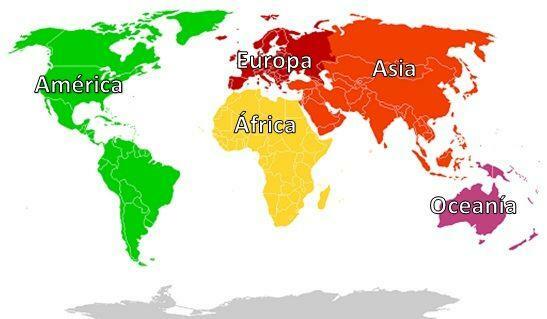ALL continents and oceans

Image: World Map - World Map
Our planet is made up of land and water, the second being much more common than the first. The groupings of both elements are called continents and oceans, and each of these groups receives its own name to differentiate itself from the rest. To comment on these elements, in this lesson from a TEACHER we are going to talk about the continents and oceans of the world with map.
To begin the lesson we must list the continents of the worldthat exist on our planet, although first we must briefly define the concept of continent, for all those people who do not know for sure what we mean by this word.
The continents are huge land masses that are divided for different reasons, such as bodies of water, cultural reasons or reasons related to the ethnicity or race of the people. In most cases they are usually separated, although there are certain exceptions such as Europe and Asia.
There is no single way to divide the continents on our planet, since depending on different factors we can talk about 7, 6 or 5 continents, but in this lesson we are going to comment on the position of the
6 continents, which we will discuss below.America
In previous lessons we have already talked about the different ways of dividing America, such as South America, North America and Central America, but in this lesson we are going to comment on the continent as a whole. It is the second largest continent with an area of 43,316,000 km2, occupying much of the western hemisphere of the planet. As for its population, which occupies around 12% of the world population, it is 1,041,034,000 inhabitants, its most populated cities being Mexico City, New York and Sao Paulo.
Asia
Asia sometimes it is united to Europe and called Eurasia, but in most cases the continents are spoken of separately. Asia's limitations are considered to be the Ural Mountains and the Indian Ocean. It is the largest continent with 45 million km², occupying almost 30% of the land surface of our planet. In Asia they live 4,140,000,000 inhabitants, being almost 70% of the world population, and having cities as populated as Tokyo, Seoul and Bombay.
Europe
Europeit is a small continent where western culture has centered. Its extension is 10,530,751 km², being the second smallest continent. On the other hand the continent has a population of 743,704,000 inhabitants, being 10% of the world population and with cities as populated as London, Paris and Moscow.
Africa
Located in southern Europe, Africait is the third largest continent with 30,272,922 km², and at the same time it is the third in population with 1,225,080,510 inhabitants, some of its most populated cities being Cairo and Lagos
Oceania
OceaniaIt is a continent made up of islands, which is why it is the smallest continent in the world with an area of 9,008,458 km2. On the other hand throughout their islands they live 40,117,432 inhabitants, with some of its most populated cities being Sidney and Melbourne.
Antarctica
On many occasions it is not considered a continent, due in part to its small population, being inhabited by a few thousand people and only temporarily. Regarding its extension, we must comment that it reaches up to 14,000,000 km2, although it may vary due to thawing.

Image: Pinterest
To conclude this lesson on the world's continents and oceans, we must talk about the oceans. We call all those oceans Earth's water masses that separate two or more continents. There are three major and two minor oceans, of which we must speak next.
Pacific Ocean
The Pacific is the largest ocean in the world, having a surface area of 200,700,000 km2, occupying a third of the Earth's surface. It borders the Arctic to the north, and to the south with Antarctica, separating the continents of America and Asia. In its water we can find the enormous amount of 25,000 islands, being a number greater than that of all the oceans combined.
Atlantic Ocean
The second largest ocean in the world with an area of 106,400,000 km2. It separates America from Africa and Europe, extending between the Arctic and Antarctic oceans. It is very important for the climate, since its position between the Old and New World causes the currents that are formed in its waters can modify to a greater or lesser extent the temperatures of the countries of both continents.
Indian Ocean
With their 73,556,000 km2 of extension is in a middle point, being smaller than the aforementioned, but much larger than the other two oceans that we are going to mention. This ocean bathes the coasts of Australia and part of Asia and Africa, thus delimiting the Atlantic, the Pacific and the Antarctic.
Antartic Ocean
One of the two smaller oceans with an extent of only 20,327,000 km2, although sometimes it is not even considered an ocean. It borders the Pacific, Atlantic and Indian Oceans, extending from Antarctica to these oceans. It is the least studied ocean of all, and its true extent is even doubted due to the thaw.
Arctic Ocean
The smallest of the oceans with an area of 14,090,000 km2. It is located north of the Arctic Circle, which is why it occupies a space between Europe, Asia and the northern part of America. During much of the year the ocean is protected by large amounts of ice, due to the low temperatures it can get, ranging from 0º C to -50º C.

